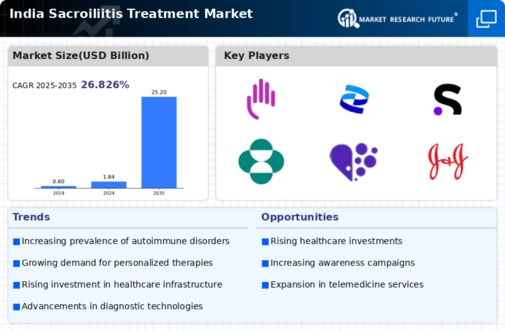Growing Geriatric Population
India's aging population is a critical factor influencing the sacroiliitis treatment market. As individuals age, the likelihood of developing musculoskeletal disorders, including sacroiliitis, increases. Projections indicate that by 2030, the geriatric population in India will reach approximately 300 million, creating a substantial demand for healthcare services, including treatments for sacroiliitis. This demographic shift suggests that healthcare providers will need to adapt their services to cater to the specific needs of older adults, potentially leading to an increase in the availability of treatment options. Consequently, the sacroiliitis treatment market may experience significant growth as healthcare systems respond to the needs of this expanding demographic.
Increased Awareness and Education
There is a notable rise in awareness and education regarding sacroiliitis and related conditions among both healthcare professionals and the general public in India. Campaigns aimed at educating patients about the symptoms and treatment options for sacroiliitis are becoming more prevalent. This increased awareness is likely to lead to earlier diagnosis and treatment, which could positively impact the sacroiliitis treatment market. Furthermore, healthcare providers are increasingly focusing on training and educating their staff about the latest treatment protocols, which may enhance the quality of care provided to patients. As a result, the market may see a boost in demand for innovative treatment solutions.
Advancements in Diagnostic Techniques
Innovations in diagnostic technologies are transforming the landscape of the sacroiliitis treatment market. Enhanced imaging techniques, such as MRI and CT scans, allow for earlier and more accurate diagnosis of sacroiliitis. This advancement is crucial, as timely diagnosis can lead to more effective treatment plans and improved patient outcomes. The Indian healthcare sector is increasingly adopting these technologies, which may lead to a rise in diagnosed cases of sacroiliitis. As a result, the demand for targeted therapies and treatment options is expected to grow, thereby driving the market forward. Moreover, the integration of artificial intelligence in diagnostics could further streamline the identification of sacroiliitis, potentially increasing the market's reach.
Rising Prevalence of Autoimmune Disorders
The increasing incidence of autoimmune disorders in India is a significant driver for the sacroiliitis treatment market. Conditions such as ankylosing spondylitis, which often coexists with sacroiliitis, are becoming more prevalent. Recent studies indicate that approximately 0.5-1% of the Indian population may be affected by ankylosing spondylitis, leading to a corresponding rise in demand for effective treatment options. This trend suggests that healthcare providers are likely to focus more on diagnosing and treating sacroiliitis, thereby expanding the market. Furthermore, the growing awareness among patients regarding autoimmune diseases is prompting them to seek medical attention sooner, which could potentially increase the market size for sacroiliitis treatments in the coming years.
Government Initiatives and Healthcare Policies
Government initiatives aimed at improving healthcare access and affordability are likely to play a pivotal role in the sacroiliitis treatment market. Policies that promote the availability of essential medications and treatments for chronic conditions can enhance patient access to necessary therapies. The Indian government has been implementing various health schemes to support patients with chronic illnesses, which may include those suffering from sacroiliitis. These initiatives could lead to increased funding for research and development in treatment options, thereby expanding the market. Additionally, public health campaigns that focus on chronic pain management may further elevate the profile of sacroiliitis treatment, encouraging more patients to seek care.























Leave a Comment